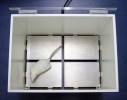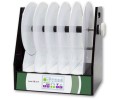Authors
R. Lalonde, M. Dumont, M. Staufenbiel, C. Strazielle.
Lab
Université de Rouen, Faculté de Médecine et de Pharmacie, INSERM U614, Rouen, France ; CHUM/St-Luc, Neuroscience Research Center, Montreal, Canada ; Novartis Institutes for Biomedical Research, Nervous System Research, Basel, Switzerland ; Université Henr
Journal
Behavioural Brain Research
Abstract
The SHIRPA primary screen comprises 40 measures covering various reflexes and basic sensorimotor functions. This multi-test battery was used to compare non-transgenic controls with APP23 transgenic mice, expressing the 751 isoform of human beta-amyloid precursor protein and characterized by amyloid deposits in parenchyma and vessel walls. The APP23 mice were distinguishable from controls by pathological limb reflexes, myoclonic jumping, seizure activity, and tail malformation. In addition, this mouse model of Alzheimer’s disease was also marked by a crooked swimming trajectory. APP23 mice were also of lighter weight and were less inclined to stay immobile during a transfer arousal test. Despite the neurologic signs, APP23 transgenic mice were not deficient in stationary beam, coat-hanger, and rotorod tests, indicating intact motor coordination abilities.
BIOSEB Instruments Used:
Aron Test or Four Plates Test (LE830),Rotarod (BX-ROD)

 Pain - Thermal Allodynia / Hyperalgesia
Pain - Thermal Allodynia / Hyperalgesia Pain - Spontaneous Pain - Postural Deficit
Pain - Spontaneous Pain - Postural Deficit Pain - Mechanical Allodynia / Hyperalgesia
Pain - Mechanical Allodynia / Hyperalgesia Learning/Memory - Attention - Addiction
Learning/Memory - Attention - Addiction Physiology & Respiratory Research
Physiology & Respiratory Research
 Pain
Pain Metabolism
Metabolism Motor control
Motor control Neurodegeneration
Neurodegeneration Cross-disciplinary subjects
Cross-disciplinary subjects Muscular system
Muscular system General activity
General activity Mood Disorders
Mood Disorders Other disorders
Other disorders Joints
Joints Central Nervous System (CNS)
Central Nervous System (CNS) Sensory system
Sensory system

